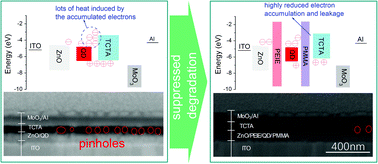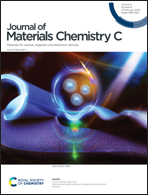Degradation of quantum dot light emitting diodes, the case under a low driving level†
Abstract
Quantum dot light emitting diodes (QLEDs) have been emerging with unique photoelectrical properties and their efficiency is rapidly approaching the commercialization requirement. However, the device operation lifetime is still one of the biggest obstacles facing the QLED applications. Here, we investigate the case of degradation of red QLEDs by a low driving level (7.5 mA cm−2) because devices can commonly achieve a luminance of ∼500–2000 cd m−2 (that is required in display applications) under this driving current. Based on the photoelectrical characteristics of QLEDs with different aging times, we find that the device stability is dominantly affected by the interfaces between QDs and adjacent charge transport layers. Some of the QDs stay in the permanent dark states (lightless states) due to the aging process, which may result from the generation of nonradiative sites in the hole-transport layer (HTL). The electron leakage should be responsible for the degradation of the HTL, leading to a highly resistive HTL and the rise of the operation voltage for the aged devices. Therefore, suppressing the interactions between QDs and charge transport layers and confining the charges within the QDs are feasible ways to boost the operation stability of QLEDs.



 Please wait while we load your content...
Please wait while we load your content...